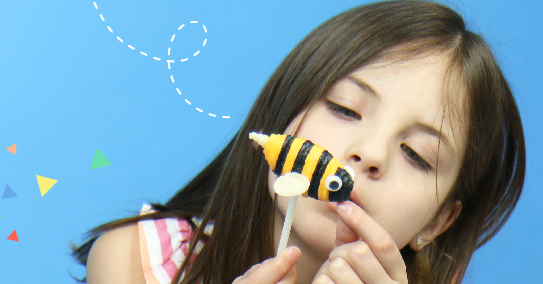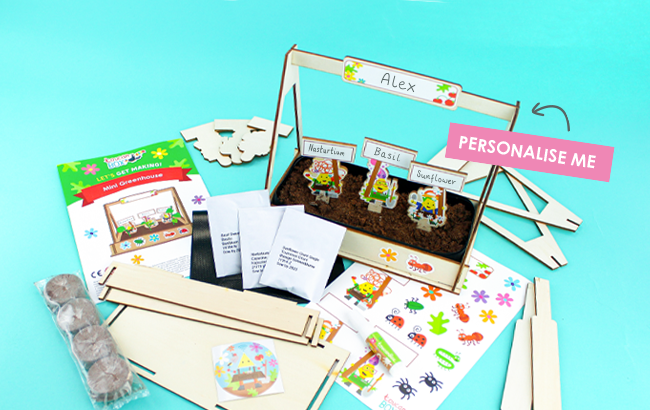Facts And Crafts All About Bees

Bees play a very important part in our ecosystem. Learn some fascinating bee facts, make your own cardboard honeycomb, and find out what you can do to protect your local bees.
Bee Facts For Kids
There are over 20,000 different species of bee in the world! So there are in fact 20,000 different looking and behaving bees: They differ in size, shape and colour. Depending on their habitat, their behaviour may also be a bit different.
Bees live in colonies that consist of the queen bee, worker bees and drone bees. The queen bee is female and her job is to lay hundreds and hundreds of eggs. In the summer, the queen bee can lay up to 2,500 eggs per day! Drone bees are all male and their only job is to mate with the queen.
Worker bees are female and they have lots of different jobs including cleaning the hive, collecting pollen and nectar, taking care of offspring and protecting the hive from intruders.
Facts about Honeybees for kids
Honeybees can fly at 25 kmph and beat their wings 200 times per second!
Honeybees are well known for their dancing skills. To tell other bees about where the best food sources are, honeybees perform a ‘waggle dance’. The bee moves in a figure of eight and waggles its body to give their other bee directions to the food. Have a go at the waggle dance at home!
As their name suggests, honeybees make honey! Honeybees gather nectar, a sweet substance produced by some plants to attract insects. The bees take the nectar back to their hive and store it in wax cells.
The nectar is mixed with a bee enzyme and the wax cells are fanned by the bees which makes it thicker and more concentrated, turning it into honey. Honeycomb is made up of lots and lots of wax cells. Once the honey is ready, the bees cover the wax cells with a layer of wax in a process called ‘capping’.
This capped honey is stored for the bees to eat during the cold months of winter when they cannot leave the hive to forage for food. The capping process also tells beekeepers that the honey is ready for harvest. Good beekeepers will make sure that they leave the bees enough honey to survive through the winter and only harvest what will be left over.
Facts about Bumblebees for kids
Bumblebees have round bodies that are covered in soft hair which makes them look fuzzy! Like honeybees, they gather nectar but instead of making it into honey, they store it in nectar pots in the hive. Bumblebees don’t make honey because they don’t need to store food for the winter as only the queen bumblebee survives and hibernates during the winter.
Unlike honeybees, bumblebees don’t perform ‘waggle dances’ to tell other bees about the location of food sources. Instead, when they return from a successful foraging expedition, they run excitedly around the hive for several minutes before going out to forage again. It is thought that the buzzing noise made by the wings of the excited bee could encourage other bumble bees to go out and forage, too.
Craft Your Own Cardboard Honeycomb Bee Craft
As part of our Cardboard Creations series, we came up with a great little craft that requires very few materials. Check out the full video below, plus the full materials list and instructions to make your very own bee honeycomb!
You Will Need
- Some cardboard
- A pencil
- A ruler
- Glue or double-sided tape
- Scissors
How To Do The Bees Craft
1 Use the ruler to draw 36 rectangles on the piece of cardboard in a 6x6 grid. The rectangles need to be 5.5cm by 4cm in size. You’ll need a little tab at the end so you can stick the cardboard strips together.
2 Cut along the 4cm edges to make the cardboard into strips.
3 Fold the card along the line. You can use the ruler to help you make straight folds.
4 Bend the strip into a hexagon shape.
5 Use the little tab to stick your hexagon together. Repeat with each cardboard strip.
6 Stick the hexagons together to make your very own honeycomb!
Save The Bees!
When collecting nectar, bees can accidentally transfer pollen between the male and female parts of plants in a process called pollination. This accident is a vital step in the reproduction of most plants as it allows them to grow seeds and fruit. Bees are extremely important in helping to pollinate flowers, fruits and vegetables, and it is estimated that one-third of the food we eat relies on pollination by bees (as well as other insects, bats and birds).
Without bees we wouldn’t have apples, broccoli (well, it could be worse), avocados (nooooo!), cherries, cucumbers, lemons, mangoes, onions, strawberries, watermelons and many more delicious fruits and vegetables! Not to mention coffee to perk up exhausted grown-ups! Phew, that’s a long list. Over the last few decades, the UK has lost 97% of its wildflower meadows, making food scarce for bees. Because of this, we need to make sure that we are doing everything we can to help bees survive. We’ve come up with three things you can do to help the bee population.
1 Plant some bee-friendly flowers in your garden. Bees love flowers that are rich in nectar such as lavender, bluebells, foxgloves, poppies and snapdragons. If you’re new to gardening, try starting with lavender in a window box. Bees can see purple more clearly than any other colour so you’ll have bees queuing up for lunch in no time!
2 Make a bee hotel. Bees don’t just need delicious nectar, they also need somewhere to stay. Learn all about bees and make your own bamboo bee hotel with The Bee Box, available as part of a toucanBox subscription.
3 Buy local honey. When you’re in the supermarket choosing which honey to pour on your porridge (or toast, or crumpets, or fruit, or yogurt… wow, honey’s yummy), make sure you choose British honey as you’ll be supporting honeybee populations in the UK.
SHARE YOUR CREATIONS WITH US
We’d love to see your creations, so why not share them on Facebook, Instagram or Twitter with #toucanBox. Our favourite snaps could feature in the next issue of toucanBox Magazine!
Not tried toucanBox yet?
Want craft projects, with all the materials you'll need, delivered straight to your door? Sign up today and save 50% on your first box!
Not ready to commit? Subscribe to our fun-filled weekly newsletter, jam packed with craft ideas, recipes, fun activities and more!




